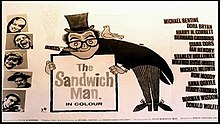fiction.wikisort.org - Movie
The Sandwich Man is a 1966 British comedy film directed by Robert Hartford-Davis and written by Hartford-Davis and Michael Bentine. The film also stars Bentine, with support from Dora Bryan, Harry H. Corbett, Bernard Cribbins, Diana Dors, Norman Wisdom, Terry Thomas, Ian Hendry and numerous other British character actors.
| The Sandwich Man | |
|---|---|
 Film Poster | |
| Directed by | Robert Hartford-Davis |
| Written by | Michael Bentine Robert Hartford-Davis |
| Produced by | Peter Newbrook |
| Starring | Michael Bentine Dora Bryan Harry H. Corbett |
| Cinematography | Peter Newbrook |
| Edited by | Peter Taylor |
| Music by | Mike Vickers |
Production company | Titan International Pictures |
| Distributed by | Rank Film Distributors |
Release date | July 1966 |
Running time | 95 minutes |
| Country | United Kingdom |
| Language | English |
| Budget | £214,452[1] |
Plot synopsis
Bentine takes the leading role, playing Horace Quilby, a mild-mannered widower living in the London Docklands. His job as a sandwich-board man requires him to wander around London immaculately wearing morning dress (top hat and tails) and carrying advertisements. He is also secretary of the Sandwichmen's Brotherhood. But his real interest in life is pigeon racing, especially 'Esmerelda', who is racing from Bordeaux to London, so Horace keeps calling at places on his route to see if there is any news.[2]
The action takes place on the streets of London with the atmosphere being quite colourful with red London Transport RT buses often in view together with all manner of vehicles (cars and vans) from saloons and hansom cab taxis to chauffeur-driven Rolls-Royces.[3]
During the course of one day, Quilby encounters a host of eccentric characters, who are played by some of Britain's best known comedy and character actors, and becomes involved in a series of capers:-
- There is an overloaded Mini Moke with a troubled scout leader behind the wheel but getting nowhere fast;
- Along comes a policeman riding a motorcycle who has had better days;
- One mildly amusing sequence follows another with plenty of stars - an ensemble cast - fleetingly doing their scene and sometimes just appearing in a background or cameo role;[4]
But the main story thread sees Quilby reunite Sue (Suzy Kendall), a young model, with her errant boyfriend Steven (David Buck).
Quilby's homing pigeon Esmerelda wins the race, and the whole of his neighbourhood join in the celebrations.
Cast
- Michael Bentine as Horace Quilby, the Sandwich Man, also Gungadin the owner of a Jazz Club.
- Dora Bryan as Mrs. DeVere
- Harry H. Corbett as Stage-Door Keeper
- Bernard Cribbins as Photographer
- Diana Dors as First Billingsgate Lady
- Ian Hendry as Policeman on Motorbike
- Stanley Holloway as Park Gardener
- Wilfrid Hyde-White as Lord Uffingham
- Michael Medwin as Sewer Man
- Ron Moody as Rowing Coach
- Anna Quayle as Second Billingsgate Lady
- Terry-Thomas as Scoutmaster
- Norman Wisdom as Boxing Vicar
- Donald Wolfit as Car Salesman
- Suzy Kendall as Sue
- Alfie Bass as Model Yachtsman
- Fred Emney as Sir Mervyn Moleskin
- Sydney Tafler as First Fish Porter
- Frank Finlay as Second Fish Porter
- Warren Mitchell as Gypsy Sid
- David Buck as Steven Mansfield
- Tracey Crisp as Girl in the Black Plastic Mac
- Earl Cameron as Bus Conductor
- Roger Delgado as Abdul, the carpet seller
- Leon Thau as Ram
- Hugh Futcher as Gogi
- Ronnie Stevens as Drunk
- Peter Jones as Escapologist (Manfred the Magnificent)
- John Le Mesurier as Senior Sandwich Man
- Max Bacon as Chef
- John Junkin as Chauffeur
- Gerald Campion as Sandwich Man in Suit of Armour
- Burt Kwouk as Ice Cream Man
- David Lodge as Charlie
- Aubrey Morris as Cedric (The Great)
- Peter Arne as Gentleman in Rolls Royce
- Jeremy Lloyd as Guardsman
- Michael Trubshawe as Guardsman
- Ewen Solon as Blind man
- Michael John Chaplin (Charlie's son) as the pavement/sidewalk artist
- Brian Cant Press photographer at East End street party
- Nosher Powell as Nosher, the bus driver
- Joe Gibbons as Man on Mowing Machine
- Deborah Bishop as Woman taking an unnatural interest in the size of Frank Finlay's sandwich
Production
The film was the second in a short lived series of co productions between the NFFC and Rank.[5] Diana Dors had recently moved back to London after several years in the USA.[6]
Reception
The film was poorly received at the time of its release, critically and commercially,[7] but has since achieved some attention especially for its backdrop of London in the Swinging Sixties.
References
- Petrie p 10
- Best Of British magazine; September 2022 issue; Page 65
- Best of British magazine; September 2022 issue; Page 65
- Best of British magazine; September 2022 issue; Page 65
- Petrie p 7-8
- Vagg, Stephen (7 September 2020). "A Tale of Two Blondes: Diana Dors and Belinda Lee". Filmink.
- Petrie p 13-14
This article needs additional citations for verification. (May 2020) |
Notes
- Petrie, Duncan James (2016). "Resisting Hollywood Dominance in Sixties British Cinema : The NFFC/Rank Joint Financing Initiative" (PDF). Historical Journal of Film, Radio and Television.
External links
- The Sandwich Man at IMDb
- The Sandwich Man at BritMovie (archived)
- Reelstreets : https://www.reelstreets.com/films/sandwich-man-the/
Другой контент может иметь иную лицензию. Перед использованием материалов сайта WikiSort.org внимательно изучите правила лицензирования конкретных элементов наполнения сайта.
WikiSort.org - проект по пересортировке и дополнению контента Википедии